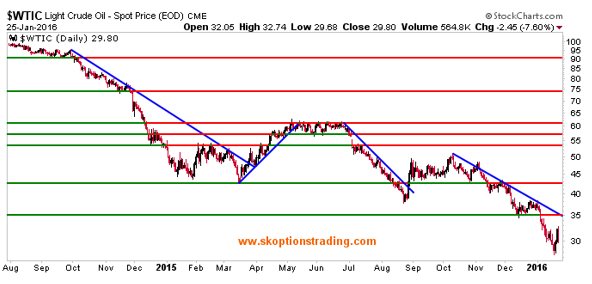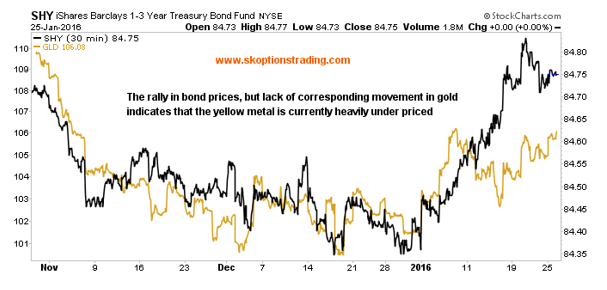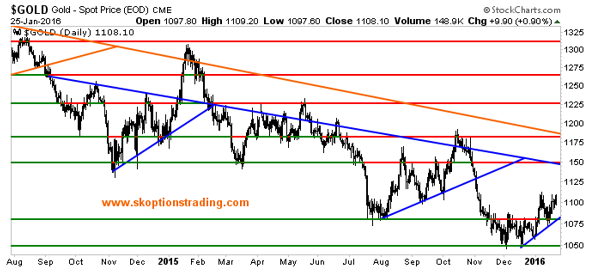Dovish Fed To Send Gold Higher
Gold and US real rates have long had an inverse relationship. Gold rallied to all-time highs while monetary policy was being made historically accommodative through quantitative easing. Then, as these measures were reduced and the Fed moved towards the beginning of a new tightening cycle a bear market in the metal began, leading the metal to almost halve from its prior highs.
However, gold failed to break to new lows when the Fed announced their first rate hike in December. When new employment data in January showed continued strength in the economy, making future hikes likely to come sooner, the metal again failed to break lower. Financial market mayhem has now made it highly unlikely that there will be more hikes in the medium term, which means that gold has no catalyst drive it lower. Instead, we believe that gold is in fact likely to have a major bullish catalyst this week: The Fed.
Why The Fed Will Not Hike
The rate hike last month was regarded by many, including us, as the beginning of a new tightening cycle for the Fed. However, since then we have seen market concerns around China’s currency devaluation and the future of the inflation situation escalate significantly, leading to mayhem in the financial markets.
This turmoil alone is enough to stop the Fed from hiking again. During the correction last year the Fed chose to not hike rates at their September meeting. The Fed reinforced that the tightening of monetary policy would be with respect to market sentiment with this decision. Investors were assured that the Fed would keep monetary policy highly accommodative and that tightening would be gradual.
This means that the Fed cannot hike during times of tumult in the markets as to do so would cost them credibility, and thus their ability to signal to their intentions. Therefore, it is near certain that the Fed will choose to leave interest rates unchanged at their meeting this week.
Disinflationary Pressures Will See a Dovish Fed
While China’s currency devaluation should not directly affect the Fed’s monetary policy decision, the effects of the devaluation will. The weakening of China’s currency means that other currencies, and in particular the US dollar, are now stronger. This means that US exports are more expensive, which makes them less competitive. The result is that economic growth in the US has the potential to be severely hurt. If growth begins to slow, inflationary pressures will fall also.
The continued decline in oil is having an increasingly negative effects on the energy sector. A lack of expansion in the energy sector means that support companies, such as the industrials, are similarly hurt. The total flow on effects of this mean that the decline in oil is now having a considerably negative effect on the economy.

Without concerns around the future of the inflation situation the Fed has the option to take a dovish stance. However, this is not the only reason that they are likely to do so. Credit spreads have widened, which means that interest rates are effectively higher without a hike. This means that the need to raise rates now to combat future inflationary pressures has been significantly reduced, as the higher borrowing costs will have a similar effect that of a January hike by tightening financial conditions.
Considering the combined impact of both a disinflationary outlook and wider credit spreads increasing borrowing costs, we can see that the Fed is likely to take more dovish action than simply leaving rates unchanged. To ease concerns around inflationary pressures and to lessen the negative impact that wider credit spreads will have on inflation, the most prudent monetary policy action is to provide a dovish statement following this meeting.
What this Means for Gold
Given the long term inverse correlation between gold and US real rates and our view that the Fed will release a dovish statement this week, we gold is highly likely to rally. The question is, by how much?
Most markets have already priced in a no hike from the Fed this week. However, while other markets may price in key action from the Fed ahead of time, gold generally does not react until after these expectations have become reality. This means that although rates staying unchanged this week is largely priced in for financial markets, gold still has the potential to have this action priced in after it has been announced.
If the Fed releases a dovish statement, as we expect that they will, then the rally in gold is likely to be substantial.
Adding to this bullish effect from the Fed is the fact that gold is underpriced relative to bonds at this point. SHY, the ETF that tracks 1 to 3 year Treasury bonds, last closed at $84.75. This level corresponds to roughly $1150 gold, but the yellow metal is currently trading $40 lower. This means that even without a dovish statement from the Fed, gold has the potential to rally to at least $1150. Therefore we believe that gold has considerable upside potential from here and high probability of achieving it.

How to Trade the Rally in Gold
There are multiple vehicles available to take advantage of a post-Fed rally in gold. GLD is an ETF that tracks gold, but this lacks any leverage to the metal. There are many who are calling to get long gold stocks to gain leveraged exposure to the yellow metal, but we believe that this would be a poor use of capital.
If one held a bullish view on gold and believed that the metal was likely to rally following this week’s Fed meeting, then it would be near contradictory to also hold the view that gold stocks will rally. The Fed will make a dovish statement if they believe the economic outlook is threatened. In this situation, stocks are likely to continue to fall, or at the least underperform, and gold mining stocks are much more likely to be sold off with equities than rally with gold.
We hold the view that the best way to gain leveraged exposure to gold is through the use of options. One strategy that we believe has particularly attractive risk reward dynamics is selling downside protection on gold. To execute this we are looking at selling March and April vertical put spreads with strikes around $100, which corresponds to approximately $1050 in gold.
These trades return between 15% and 25% if gold is above $1050 at expiry. Now, these returns are not astronomical, but the downside risk is very low here. If gold rallies after the Fed meeting this week as we believe it will, it is likely that the metal will move above support at $1150 to challenge resistance at $1180 and the long term downtrend. This movement makes it extremely likely that gold will remain above support at $1050.

Therefore we believe the risk reward dynamics on this type of trade are highly favourable at this point and as a result are our vehicle of choice. Should gold continue to rally higher and break through the long term downtrend line, then we will look to take a much more aggressive position on the metal, such as buying calls on GLD.



